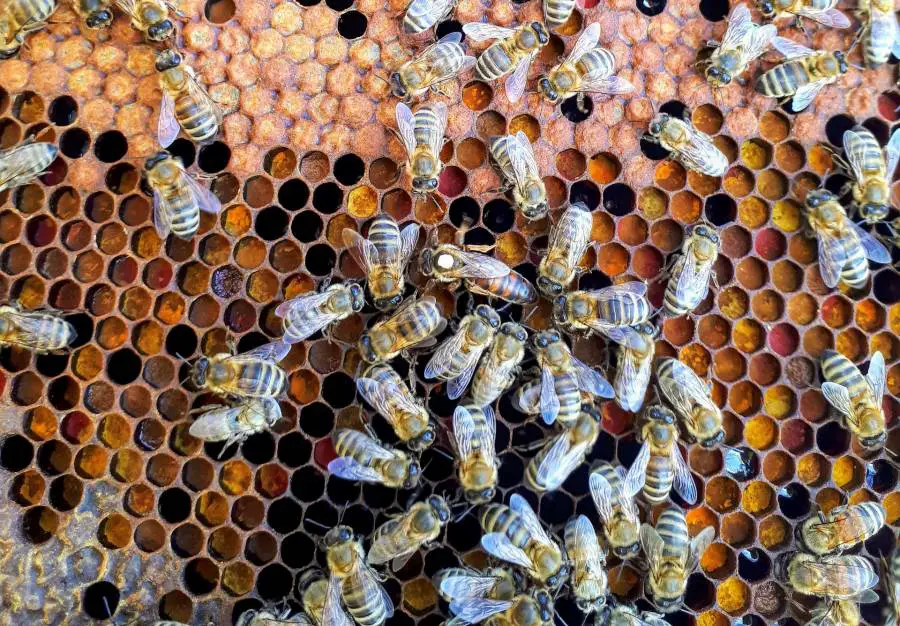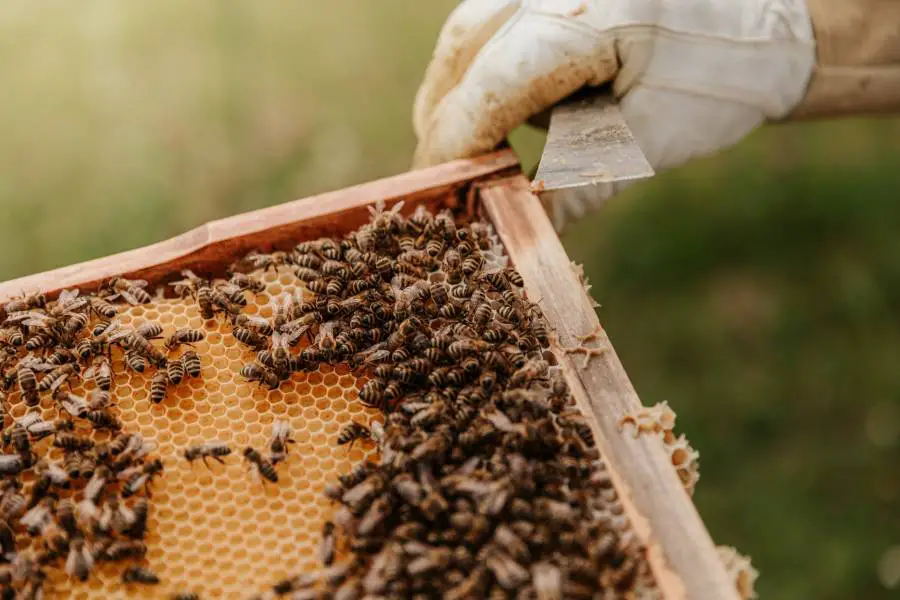Table of Contents
In agricultural production, pollination by bees helps increase yields and produce superior-quality harvests.
In the United States alone, pollination by managed bee colonies adds at least $15b to the US agriculture value through increased yield.
Agricultural value is also added through superior-quality production of harvests annually.

Over the past years, managed bees have come under severe attacks by various stresses, which resulted in beekeepers losing colonies.
Colony collapse disorder (CCD) is one such issue involving beekeeping. Colony collapse disorder occurs when worker bees abruptly leave the colony.
This phenomenon leaves behind only a few nursing bees, plenty of food, the queen, and young bees.
Causes Of Colony Collapse Disorder
The mechanisms of colony collapse disorder are still very much unknown. However, several causes are being considered to contribute to this effect.
Agrochemicals, parasites, fungi, beekeeping methods (such as the use of antibiotics, lengthy movement of beehives), diseases, and malnourishment factors are among the causes.
Other causes include poor quality queens, hunger, immunodeficiency, and others. The current idea is that no single component causes colony collapse disorder.
But some of these variables may interact to generate colony collapse disorder.
Colony Collapse Disorder Working Group (CCDWG), based in Pennsylvania, was established in 2006.
They wanted to know what causes colony collapse disorder in hives. Their findings revealed no definite etiology of the condition.
A survey of beekeepers conducted in 2007 revealed that most recreational beekeepers believed that malnutrition was the primary cause of the disorder.
The survey also showed that commercial beekeepers believed pests were the primary cause of colony collapse disorder.
Through questionnaires and data gathering, the United States Department of Agriculture’s Agricultural Research Service conducted some studies.
The studies were better for identifying the likely causes of colony collapse disorder. Several causes have been proposed.
These include contamination of the environment of colony food stores or beeswax, a lack of genetic variations in colonies, and pesticide toxicity.
Several other studies have shown that colony collapse disorder might result from colonies’ infection.
This infection usually involves two or more pathogens at the same time.
It could also be a combination of more than one stressor where they have a synergistic effect on the colony. The most prominent causes are identified below.
Pesticide
One theory blames pesticides, specifically a class of insecticides called neonicotinoids.
These pesticides are applied to crops and work their way into the pollen and nectar that bees feed on.
Furthermore, the use of certain pesticides has been linked to increased levels of stress in bees.
During CCD, most or all of the worker bees in a colony disappear. It leaves behind a queen, a few drones, and a small number of juvenile bees.
It leaves the colony unable to survive and ultimately results in its collapse.
Infection
Infection as a cause of colony collapse disorder (CCD) is a theory that has been gaining traction in recent years.
The primary evidence for this theory is that CCD typically occurs during the winter months.
In the winter months, bees are more likely to be exposed to pathogens.
Additionally, many of the symptoms of CCD are similar to those of other bee diseases, such as European foulbrood.
These symptoms most often appear like those of American foulbrood. A variety of pathogens have been found in hives that have experienced CCD.
Also, infection with some of these pathogens can result in colony loss in honey bees.
While there is still much to learn about CCD, the infection theory is a good explanation for this devastating phenomenon. If true, it would mean that CCD.
However, the role of infection in CCD has not been conclusively demonstrated. Several diseases and viruses have been linked to colony collapse disorder.
They include; Acute bee paralysis virus, Ascospaera Apis (chalkbrood disease), Israeli acute bee paralysis virus, and deformed wing virus.
Chronic bee paralysis virus, iridescent invertebrate virus, Kashmir bee virus, Paenibacillus larvae (American foulbrood), and sacbrood virus are among them.
No single pathogen can cause colony collapse disorder singlehandedly unless it infects the colony in combination with other infective pathogens.
Bee colonies suffering from colony collapse disorder usually present with heavier infective pathogens.

Stress
There is a growing body of evidence linking stress to colony collapse disorder.
While the precise cause of CCD is still unknown, it is clear that stress is a major contributing factor. One of the most common stressors for bees is a lack of food.
In many areas of the world, bee populations struggle to find adequate nutrition sources. It is due in part to the loss of wildflower habitats.
Food scarcity is also caused by the widespread use of pesticides that kill the bees’ natural prey. Another major stressor is climate change.
It occurs in the forms of global warming, etc.
According to a study, CCD is likely caused by a combination of stressors, including parasites, pathogens, pesticides, and climate change.
However, the researchers found that stress is the primary driver of CCD.
The study was conducted by scientists from the University of California, San Francisco, and the University of California, Davis.
When bees are under stress, their immune systems are weakened, making them more susceptible to disease.
Additionally, stressed bees are more likely to make mistakes when foraging, which can lead to them getting lost and not being able to find their way.
Insecticide
Insecticide use has been implicated as a cause of colony collapse disorder, the sudden and widespread die-off of honey bee colonies.
Various insecticides, including neonicotinoids, organophosphates, and pyrethroids, have been found in the wax, pollen, and bees of such colonies.
There is strong evidence that neonicotinoids are harmful to bees and that even low levels of exposure can be deadly.
Neonicotinoids are systemic pesticides that are absorbed into the plant and distributed throughout its tissues.
There is evidence that neonicotinoids have harmful effects on bees at levels below what is considered lethal.
These sublethal effects can include impaired navigation, foraging ability, and memory. These effects can lead to colony failure as bees cannot perform essential tasks.
These survival tasks, such as gathering food and pollen or caring for the bees, become challenging to perform.
Genetic Variation
The complete sequence of the honeybee genome was published in 2006.
It is a significant scientific achievement that could help understand the underlying causes of colony collapse in bee colonies.
The genome sequencing will also help solve the CCD problem plaguing the bee kingdom for years.
It also helped the scientists to study the impact of pathogens and causative agents on specific genes and honeybees generally.
Similarly, the advanced knowledge of the genetic makeup of the bees will help loosen the complex effects of the combinations of multiple pathogens and environmental toxins.
Prevention
We must encourage those practices that enhance the health of honeybees and prevent colony collapse disorder.
In doing this, the causes of colony collapse disorder will be significantly mitigated. Beekeeping is one such practice to prevent colony collapse disorder.
It involves an individual – a watchman. You can become a beekeeper.
By setting up your bee hive, you introduce them to your area and help boost their population.
This operation can be a small single bee hive which is generally low-cost and can produce a great result.
It is an effort that is good for your immediate environment and even yields honey for the keeper.
However, beekeepers must take steps to mitigate the effects and spread of colony collapse disorder.
They must practice ethical and good beekeeping methods such as follows:
- As a beekeeper, you must respect the colony’s needs over your own needs for optimum results. You must provide them with the best environment and domestic life possible.
- Make sure to replace the old comb with a new one every few years to avoid the build-up of chemicals in them.
- Reduce stress on your bees by making available good ventilation and feeding them as appropriate. You must replace your equipment when you notice symptoms of infections such as Varroa mite and provide treatments on time.
- As much as possible, avoid using chemicals and pesticides in your garden, lawn, or on the bees. One of the suspected reasons for colony collapse disease is exploitation or overuse. If at all feasible, avoid using any form of chemicals on your bees.
- Finally, cultivate bee-friendly vegetation. Plants that are appealing to bees should be kept in the garden. It will keep your bees away from plants that have been sprayed with pesticides.
Conclusion
Honeybees are one of man’s most significant insects. Their plant-pollinating actions provide us with the best harvests and food, reducing food scarcity overall.
The extinction of bees would result in a food crisis and an increase in food prices. We must prioritize practices that keep them safe.
The mechanisms and progress of colony collapse disorder are not thoroughly understood.
As a result, we must follow the suggested beekeeping ethics and the recommendations of professionals and agencies.
Our honeybees are our saviors; treat them as such.

![It Sounds Like Water Constantly Running In House [Causes] It Sounds Like Water Constantly Running In House [Causes]](https://homesteadandprepper.com/wp-content/uploads/2021/04/why-does-it-sound-like-water-is-constantly-running-in-my-house-150x150.jpg)

![Why Does My Bathroom Smell? [All Causes] Why Does My Bathroom Smell? [All Causes]](https://homesteadandprepper.com/wp-content/uploads/2021/05/Why-Does-My-Bathroom-Smell-150x150.jpg)




